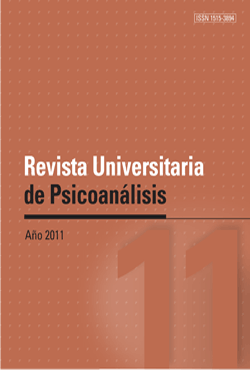Algunas consideraciones sobre la folie à deux.
Some considerations about the folie à deux
Autor/es: María Laura Valcarce
RESUMEN
Palabras clave:
The notion of folie à deux has been studied by outstanding French psychiatrists of the 19th century, who from their clinical observations tried to specify and to delimit what in different ways was called madness of two. The particularity of this psychopathological phenomenon is that it is not a question of a patient alone. The observations allowed to demonstrate the existence of a delirium shared at least by two persons, generally members of the same family. This phenomenon acquired an enigmatic character as for the manners of passage and transmission of the disease from a subject to another: What is it that is transmitted? What is the statute of something that can be displaced from one to another? In what conditions does this transmission take place? And under what modalities?
The present work shows the changes in the notion of folie à deux along the 19th century, and then how Lacan\'s position differentiates from these classic theorizations. The developments of Lasègue and Falret, Legrand du Saulle, Régis,Marandon de Montyel and of De Clérambault, are approached, articulating the contributions that each one stamped on the conceptualization and delimiting of this phenomenon.
SUMMARY
La noción de folie à deux ha sido trabajada por destacados psiquiatras franceses del siglo XIX, quienes a partir de sus observaciones clínicas intentaron precisar y delimitar lo que de diferentes maneras se denominó locura de dos. La particularidad de este fenómeno psicopatológico consiste en que no se trata de un solo enfermo, sino que las observaciones realizadas permitían demostrar la existencia de un delirio compartido al menos por dos personas, generalmente integrantes de la misma familia. Este fenómeno adquirió un carácter enigmático en cuanto a los modos de pasaje y transmisión de la enfermedad de un sujeto a otro: ¿Qué es lo que se transmite?, ¿Qué estatuto tiene aquello que puede ser desplazado de uno a otro?, ¿En qué condiciones se produce esta transmisión? y ¿Bajo qué modalidades?
El presente trabajo sitúa el recorrido que presentó la noción de folie à deux a lo largo del siglo XIX, para luego diferenciar la posición de Lacan respecto de estas teorizaciones clásicas. Se abordan los desarrollos de Lasègue y Falret, de Legrand du Saulle, de Régis, de Marandon de Montyel y de G. de Clérambault, articulando los aportes que cada uno imprimió en la conceptualización y delimitación de este fenómeno.
Keywords:
Locura de dos - Contagio - Locura simultánea - Locura comunicada
Secretaría e Instituto de Investigaciones
Lavalle 2353
Tel/fax:4952 – 5481/ 4952 – 5490
Horario de atención: 10 a 17 hs
E-mail:
instinve@psi.uba.ar











